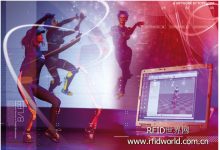
RFID Improves Video Game Development
[ad_1]
Dutch 3D tracking software design company Xsens Technologies has improved video game development and special effects design in the action film industry by using ultra-wideband (UWB) RFID technology to instantly obtain real-time action information of several actors.
Xsens incorporates UWB real-time location technology using Time Domain to enhance its full body cameraless motion capture system – “MVN”. MVN is designed to make it easier for other video game and entertainment industry companies such as Electronic Arts, Industrial Light and Magic, Sony Pictures Imageworks, THQ and others to digitally replicate the actual movements of actors.
MVN uses a distributed network of 17 inertial sensors that use accelerometers and rate gyroscopes to track movements in 3D (inertial sensors are used in Nintendo Wii remote control devices and Wii MotionPlus to determine player movements). Inertial sensors are attached to the actor’s clothing to form a wireless network.
Actors who play characters in video games wear a sensor-wired costume. Video effects designers use sensors to track and capture actors’ joints, heads, hands, feet, and full-body movements in real time, recreating them in video game scenes. The sensor communicates with a transponder worn on the actor’s body, which uses Xsens’ proprietary protocol to wirelessly send data to a receiver connected to a laptop or desktop computer – eliminating line-of-sight limitations with existing camera systems.

MVN uses sensors to track actual actor movements and reproduce them in video games
Sensor data is processed by Xsens’ MVN Studio software, which provides real-time motion capture video, playback and editing. With MVN Studio software, users can choose to import real-time data into other software, such as Autodesk Maya and 3DS Max, or export files in a variety of formats.
The Xsens MVN system does not use UWB tags, but the company integrates Time Domain’s PLUS tags and real-time positioning system to supplement precise and absolute position data, and several actors can use the MVN device at the same time; the company claims, this eliminates the need to independently record each actor’s Action, which digitally integrates actual actor actions into a scene in a video game.
TimeDomain’s PLUS system measures the time it takes for a UWB signal to travel from a tag to a PLUS reader installed in the room or in the surrounding area. Xsens integrates temporal data with inertial sensor data, improving the sensor’s accuracy and update rate, as well as the exact location of the object being tracked in 3D.
The PLUS network provides indoor location information with an accuracy that Wi-Fi or other RTLS technologies can’t achieve, according to Greg Clawson, senior associate director at Time Domain. “Sensors are placed on the feet or on the body,” he said, “depending on the scene, or the action that a scene is going to capture.”
Xsens uses Time Domain standard PLUS battery powered tags, readers and antenna housings. The company paints the equipment black to blend in with the rest of the equipment in video game and movie scenes. Time Domain’s sync port provides timing and power to the system. Xsens wrote a set of algorithms to capture location data into software applications.
The sensor system’s PLUS battery powered tags transmit UWB signals and ID codes. The signal is received by the reader and antenna. The system uses at least three readers to locate the tag and determine its precise location. A synchronization and distribution board provides time signals to all connected UWB PLUS readers, synchronizes the readers, and connects the readers to a PC or laptop via a local area network.
In the past, Xsens systems could track an object, but not its absolute position in space, said Xsens creator and CTO Per Slycke. “Now we don’t need a camera system to track human movement. EA can use our MVN technology to create games for Microsoft Xbox 360 or Sony PlayStation,” he said.
Xsens also plans to roll out the technology to the medical industry, where doctors can use the same technology to assess knee or shoulder motion in patients before and after surgery.
[ad_2]



